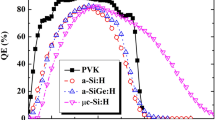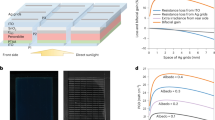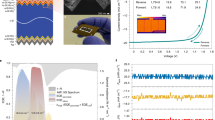Abstract
Bifacial monolithic perovskite/silicon tandem solar cells exploit albedo—the diffuse reflected light from the environment—to increase their performance above that of monofacial perovskite/silicon tandems. Here we report bifacial tandems with certified power conversion efficiencies >25% under monofacial AM1.5G 1 sun illumination that reach power-generation densities as high as ~26 mW cm–2 under outdoor testing. We investigated the perovskite bandgap required to attain optimized current matching under a variety of realistic illumination and albedo conditions. We then compared the properties of these bifacial tandems exposed to different albedos and provide energy yield calculations for two locations with different environmental conditions. Finally, we present a comparison of outdoor test fields of monofacial and bifacial perovskite/silicon tandems to demonstrate the added value of tandem bifaciality for locations with albedos of practical relevance.
This is a preview of subscription content, access via your institution
Access options
Access Nature and 54 other Nature Portfolio journals
Get Nature+, our best-value online-access subscription
$29.99 / 30 days
cancel any time
Subscribe to this journal
Receive 12 digital issues and online access to articles
$119.00 per year
only $9.92 per issue
Buy this article
- Purchase on Springer Link
- Instant access to full article PDF
Prices may be subject to local taxes which are calculated during checkout




Similar content being viewed by others
Data availability
All data generated or analysed during this study are included in the published article and its Supplementary Information
References
Best-Research Cell Efficiency Chart (NREL, 2020).
Aydin, E., De Bastiani, M. & De Wolf, S. Defect and contact passivation for perovskite solar cells. Adv. Mater. 31, 1900428 (2019).
Al-Ashouri, A. et al. Conformal monolayer contacts with lossless interfaces for perovskite single junction and monolithic tandem solar cells. Energy Environ. Sci. 12, 3356–3369 (2019).
Leijtens, T., Bush, K. A., Prasanna, R. & McGehee, M. D. Opportunities and challenges for tandem solar cells using metal halide perovskite semiconductors. Nat. Energy 3, 828–838 (2018).
Allen, T. G., Bullock, J., Yang, X., Javey, A. & De Wolf, S. Passivating contacts for crystalline silicon solar cells. Nat. Energy 4, 914–928 (2019).
Aydin, E. et al. Zr‐doped indium oxide (IZRO) transparent electrodes for perovskite‐based tandem solar cells. Adv. Funct. Mater. 29, 1901741 (2019).
Dewi, H. A. et al. Highly efficient semitransparent perovskite solar cells for four terminal perovskite–silicon tandems. ACS Appl. Mater. interfaces 11, 34178–34187 (2019).
Chen, B. et al. Enhanced optical path and electron diffusion length enable high-efficiency perovskite tandems. Nat. Commun. 11, 1257 (2020).
Chen, B. et al. Blade-coated perovskites on textured silicon for 26%-efficient monolithic perovskite/silicon tandem solar cells. Joule 4, 850–864 (2020).
Elshorbagy, M. H. et al. A monolithic nanostructured-perovskite/silicon tandem solar cell: feasibility of light management through geometry and materials selection. Sci. Rep. 10, 1–8 (2020).
Duong, T. et al. High efficiency perovskite–silicon tandem solar cells: effect of surface coating versus bulk incorporation of 2D perovskite. Adv. Energy Mater. 10, 1903553 (2010).
Hou, Y. et al. Efficient tandem solar cells with solution-processed perovskite on textured crystalline silicon. Science 367, 1135–1140 (2020).
Sahli, F. et al. Fully textured monolithic perovskite/silicon tandem solar cells with 25.2% power conversion efficiency. Nat. Mater. 17, 820–826 (2018).
Liang, T. S. et al. A review of crystalline silicon bifacial photovoltaic performance characterisation and simulation. Energy Environ. Sci. 12, 116–148 (2019).
Asadpour, R., Chavali, R. V., Ryyan Khan, M. & Alam, M. A. Bifacial Si heterojunction–perovskite organic–inorganic tandem to produce highly efficient (\(\eta_T^*\) ∼33%) solar cell. Appl. Phys. Lett. 106, 243902 (2015).
Onno, A. et al. Predicted power output of silicon-based bifacial tandem photovoltaic systems. Joule 4, 580–596 (2020).
Dupré, O. et al. Design rules to fully benefit from bifaciality in two-terminal perovskite/silicon tandem solar cells. IEEE J. Photovolt. 10, 714–721 (2020).
Geerligs, L. J., Zhang, D., Janssen, G. J. M. & Luxembourg, S. L. 4-Terminal and 2-Terminal Tandem Modules in Bifacial Operation: Model Analysis and Comparison http://resolver.tudelft.nl/uuid:a06611b9-78b2-46dd-8a04-ca02cac50111 (2018).
Coletti, G. et al. Bifacial four-terminal perovskite/silicon tandem solar cells and modules. ACS Energy Lett. 5, 1676–1680 (2020).
Onno, A., Chen, C., Koswatta, P., Boccard, M. & Holman, Z. C. Passivation, conductivity, and selectivity in solar cell contacts: concepts and simulations based on a unified partial-resistances framework. J. Appl. Phys. 126, 183103 (2019).
Lehr, J. et al. Energy yield modelling of perovskite/silicon two-terminal tandem PV modules with flat and textured interfaces. Sustain. Energy Fuels 2, 2754–2761 (2018).
Lehr, J. et al. Energy yield of bifacial textured perovskite/silicon tandem photovoltaic modules. Sol. Energy Mater. Sol. Cells 208, 110367 (2020).
Jacobs, D. A. et al. Light management: a key concept in high-efficiency perovskite/silicon tandem photovoltaics. J. Phys. Chem. Lett. 10, 3159–3170 (2019).
Gharibzadeh, S. et al. Record open‐circuit voltage wide‐bandgap perovskite solar cells utilizing 2D/3D perovskite heterostructure. Adv. Energy Mater. 9, 1803699 (2019).
Hoke, E. T. et al. Reversible photo-induced trap formation in mixed-halide hybrid perovskites for photovoltaics. Chem. Sci. 6, 613–617 (2015).
Boccard, M. & Ballif, C. Influence of the subcell properties on the fill factor of two-terminal perovskite–silicon tandem solar cells. ACS Energy Lett. 5, 1077–1082 (2020).
Köhnen, E. et al. Highly efficient monolithic perovskite silicon tandem solar cells: analyzing the influence of current mismatch on device performance. Sustain. Energy Fuels 3, 1995–2005 (2019).
Bush, K. A. et al. 23.6%-efficient monolithic perovskite/silicon tandem solar cells with improved stability. Nat. Energy 2, 1–7 (2017).
Holman, Z. C. et al. Parasitic absorption in the rear reflector of a silicon solar cell: simulation and measurement of the sub-bandgap reflectance for common dielectric/metal reflectors. Sol. Energy Mater. Sol. Cells 120, 426–430 (2014).
Liu, H. et al. A worldwide theoretical comparison of outdoor potential for various silicon-based tandem module architecture. Cell Rep. Phys. Sci. 1, 100037 (2020).
Guerrero-Lemus, R., Vega, R., Kim, T., Kimm, A. & Shephard, L. Bifacial solar photovoltaics—a technology review. Renew. Sustain. Energy Rev. 60, 1533–1549 (2016).
Aydin E. et al. Room-temperature-sputtered nanocrystalline nickel oxide as hole transport layer for p–i–n perovskite solar cells. ACS Appl. Energy Mater. 1, 6227–6233 (2018).
Zhan, T., Xiong, J., Lee, Y.-H., Chen, R. & Wu, S.-T. Fabrication of Pancharatnam–Berry phase optical elements with highly stable polarization holography. Opt. Express 27, 2632–2642 (2019).
Baker‐Finch, S. C. & McIntosh, K. R. Reflection of normally incident light from silicon solar cells with pyramidal texture. Prog. Photovolt. Res. Appl. 19, 406–416 (2011).
Wilcox, S. & Marion, W. Users Manual for TMY3 Data Sets NREL/TP-581-43156 (NREL, 2008).
Gueymard, C. A. Parameterized transmittance model for direct beam and circumsolar spectral irradiance. Sol. Energy 71, 325–346 (2001).
Schmager, R. et al. Methodology of energy yield modelling of perovskite-based multi-junction photovoltaics. Opt. Express 27, A507–A523 (2019).
Baldridge, A. M., Hook, S., Grove, C. & Rivera, G. The ASTER spectral library version 2.0. Remote Sens. Environ. 113, 711–715 (2009).
Sun, X., Khan, M. R., Deline, C. & Alam, M. A. Optimization and performance of bifacial solar modules: A global perspective. Appl. Energy 212, 1601–1610 (2018).
Hottel, H. C. & Sarofim, A. F. Radiative Transfer (McGraw-Hill, 1967).
Appelbaum, J. View factors to grounds of photovoltaic collectors. J. Solar Energy Eng. 138, 064501 (2016).
Acknowledgements
This work was supported by the King Abdullah University of Science and Technology (KAUST) Office of Sponsored Research (OSR) under award no. OSR-2018-CPF-3669.02, KAUST OSR-CARF URF/1/ 3079-33-01, KAUST OSR-CRG RF/1/3383, KAUST OSR-CRG2018-3737 and IED OSR-2019-4208. This work was supported in part by the US Department of the Navy, Office of Naval Research (grant award no. N00014-20-1-2572). The financial support of the German Federal Ministry for Economic Affairs and Energy (CAPITANO, funding code 03EE1038B) and the Initiating and Networking funding of the Helmholtz Association (HYIG to U.W.P. (funding code VH-NG1148), PEROSEED (funding code ZT-0024) and the Science and Technology of Nanostructures Research Program) is acknowledged. Furthermore, we are grateful for the help and support of A. Mertens and A. Rozalier from KIT in setting up the outdoor measurements in Karslruhe as well as M. Langenhorst, R. Schamger and J. Lehr for developing earlier versions of the energy-yield software. We acknowledge the support of ABET Technologies and Newport. We thank TUV Rheinland Group, Germany, for providing solar spectra from TUV’s outdoor test field on the KAUST campus, Thuwal, Saudi Arabia. We are grateful for the support of J. L. Mynar and the KAUST Corelab, and for the fruitful discussions with A. H. Balawi.
Author information
Authors and Affiliations
Contributions
M.D.B. conceived the idea; M.D.B. and A.J.M. fabricated the devices; Y.H., B.C. and A.S.S. developed the perovskite bandgaps; E.A. developed the tandem top contact and layout; E.A. and F.H.I. developed the tandem hole transport layer; M.D.B., T.G.A. and E.V.K. developed the silicon bottom cell; F.G., U.W.P. and L.X. performed the optical modelling; J.L. performed the electrical modelling; M.F.S., F.G., J.T. and J.L. developed the field-test set-up; F.G. and U.W.P. performed the energy-yield calculations; M.F.S. supervised the field-test experiment; M.D.B., M.F.S., A.S.S., F.G. and U.W.P. wrote the manuscript; D.B., B.F., E.H.S. and S.D.W. supervised the project.
Corresponding authors
Ethics declarations
Competing interests
The authors declare no competing interests.
Additional information
Peer review information Nature Energy thanks Gianluca Coletti and the other, anonymous, reviewer(s) for their contribution to the peer review of this work.
Publisher’s note Springer Nature remains neutral with regard to jurisdictional claims in published maps and institutional affiliations.
Supplementary information
Supplementary Information
Supplementary Figs. 1–17, Tables 1–6 and Note 1.
Rights and permissions
About this article
Cite this article
De Bastiani, M., Mirabelli, A.J., Hou, Y. et al. Efficient bifacial monolithic perovskite/silicon tandem solar cells via bandgap engineering. Nat Energy 6, 167–175 (2021). https://doi.org/10.1038/s41560-020-00756-8
Received:
Accepted:
Published:
Issue Date:
DOI: https://doi.org/10.1038/s41560-020-00756-8
This article is cited by
-
Stability challenges for the commercialization of perovskite–silicon tandem solar cells
Nature Reviews Materials (2023)
-
All-perovskite tandems go bifacial
Light: Science & Applications (2023)
-
Design optimization of bifacial perovskite minimodules for improved efficiency and stability
Nature Energy (2023)
-
Charge transport materials for monolithic perovskite-based tandem solar cells: A review
Science China Materials (2023)
-
Recent progress in bifacial perovskite solar cells
Applied Physics A (2023)



